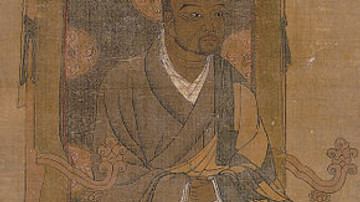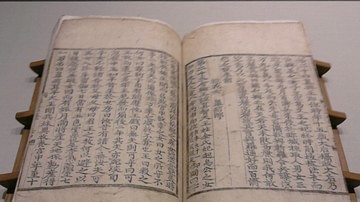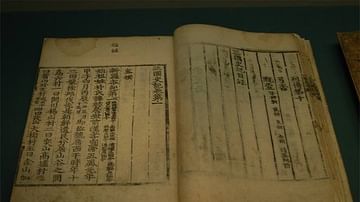
Hyangga was a form poetical 'country song,' distinct from contemporary Chinese songs, which were written in the Silla and Goryeo kingdoms of ancient Korea between the 7th and 10th century CE. The indigenous songs cover such topics as love, loss, and Buddhist devotion. The majority are written in couplets arranged in four-line stanzas with each line having four syllables. The poems were designed to be sung accompanied by music and dancing. Only 25 hyangga survive, but they were once widely written and performed, including by such famous figures as Wonhyo, the Buddhist philosopher-monk.
Composition & Structure
The hyangga, also known as saenaennorae, were written in idu, that is the Korean language written using Chinese characters. In hyannga, the Chinese characters are used to represent not only meanings but also the sounds of Old Korean in a technique known as hyangchal. The hyangga are the oldest examples of this form of writing. They may have developed from the earlier singa, songs sung by shamans during rituals.
Only 25 songs survive; 14 are to be found in the Samguk Yusa ('Memorabilia of the Three Kingdoms'), the 13th-century CE collection of texts on Korean history and culture compiled by the Buddhist scholar-monk Iryon. The remaining 11 songs appear in the Kyunyo-jon. In 888 CE, the Samdaemok ('Collection of the Three Periods'), an anthology of hyangga, was compiled by the monk Daegu and Silla Prime Minister Wihong, but it was unfortunately destroyed in the 13th-century CE Mongol invasions of Korea.
Most songs are composed of 10 lines with two four-line stanzas, each with two couplets, and then a closing couplet. The ninth line invariably begins with an interjection, raising the speaker's intonation and signalling the finale of the song which usually contains a wish, command, or exclamation. The genre died out in the 11th century CE, replaced with a long-lasting fashion amongst intellectuals for purely Chinese literature.
Four-line Hyangga
Four of the surviving hyangga have only four lines. Here is one example, titled Honhwa ka or 'Dedication of the Flower.' It was composed in the first decades of the 8th century CE and sung by an old herdsman. One day the herdsman meets Lady Suro, wife of Lord Sunjong, and her entourage touring the countryside. The lady asks for an azalea flower growing on a high cliff but the only person to respond is the herdsman. Giving Lady Suro the flower he sings:
If you would let me leave
The cattle tethered to the brown rock,
And feel no shame for me,
I would pluck and dedicate the flowers!
(Lee, P.H. 71)
Eight-line Hyangga
There are three surviving hyangga which have two stanzas of four lines each (although one of them may have lost its last two lines). In this example, written by Tugo and titled Mo Chukchirang ka or 'Ode to Knight Chukchi' written c. 692-702 CE, the author praises his master:
All living beings sorrow and lament
Over the spring that is past;
Your face once fair and bright
Is about to wear deep furrows.
I must glimpse youEven for an awesome moment.
My fervent mind cannot rest at night
In the mugwort-rank hollow.
(Lee, P.H., 72)
The most famous surviving hyangga of all is the Song of Choyong (Choyong ka), composed in 879 CE, which is another eight-line song. The title character is the son of the Dragon King of the Eastern Sea, who one night after a party returns home to find his beautiful wife being seduced by the Spirit of Smallpox. Choyong was forgiving, though, and in return the spirit promised never to enter a house which had a portrait of our hero on the door. This is the song which Choyong sang so charmingly to the spirit so that he left in peace:
Having caroused far into the night
In the moonlit capital,
I returned home and in my bed,
Behold four legs.
Two were mine;Whose are the other two?
Formerly two were mine;
What shall be done now they are taken?
(Lee, P.H., 73)
Choyong has been identified as a shaman for his calm yet magical success in dealing with the spirit. The spirit itself may be a metaphor for the ills of the world. Performers of hyangga often wore masks, and the Song of Choyong gave rise to a later tradition of wearing a Choyong mask on New Year's Eve to chase away evil spirits. The dance of the Choyong hyangga became a popular court ceremony during the Joseon (Choson) dynasty (1392-1910 CE).
Ten-line Hyangga
The remaining 18 hyangga are all ten-line songs. In our first example, the theme is the separation caused by death. The title is Chae mangmae ka or 'Requiem for the Dead Sister,' and it was composed c. 762 CE by Master Wolmyong in honour of his own lost sister:
On the hard road of life and death
That is near our land,
You went, afraid,
Without words.
We know not where we go,Leaves blown, scattered,
Though fallen from the same tree,
By the first winds of autumn.
Ah, I will polish the pathUntil I meet you in the Pure Land.
(Lee, P.H., 75)
In the Hyesong ka or 'Song of a Comet' by Master Yungchong the performance of the hyangga reportedly worked a miracle not once but twice when it saw off a comet – traditionally an inauspicious omen and often referred to as a long-tailed star – and a fleet of Japanese pirates.
There is a castle by the Eastern Sea,
where once a mirage used to play.
Japanese soldiers came,
Torches were burnt in the forest.
When knights visited this mountain,The moon marked its westerly course
And a star was about to sweep a path,
Someone said, “Look, there is a comet.”
Ah, the moon has already departed.Now, where shall we look for the long-tailed star?
(Lee, P.H., 74)
In a final example, this song, written by the great poet-scholar monk Master Kyunyo (923-973 CE), calls for the turning of the dharma wheel. It is untitled but was part of a group of 11 hyangga titled 'Ten Vows of Bodhisattva Samantabhadra.' In the last couplet the moon is used, as was typical in Buddhism, as a metaphor for enlightenment.
To the majestic assembly of buddhas
In the dharma realm,
I go forth and pray
For the dharma rain.
Disperse the blight of afflictionRooted deep in the soil of ignorance,
And wet the mind's field of living beings,
Where good grasses struggle to grow.
Ah, how happy is a moonlit autumn field,Ripe with the fruit of knowledge.
(Lee, P.H., 82)
This content was made possible with generous support from the British Korean Society.





